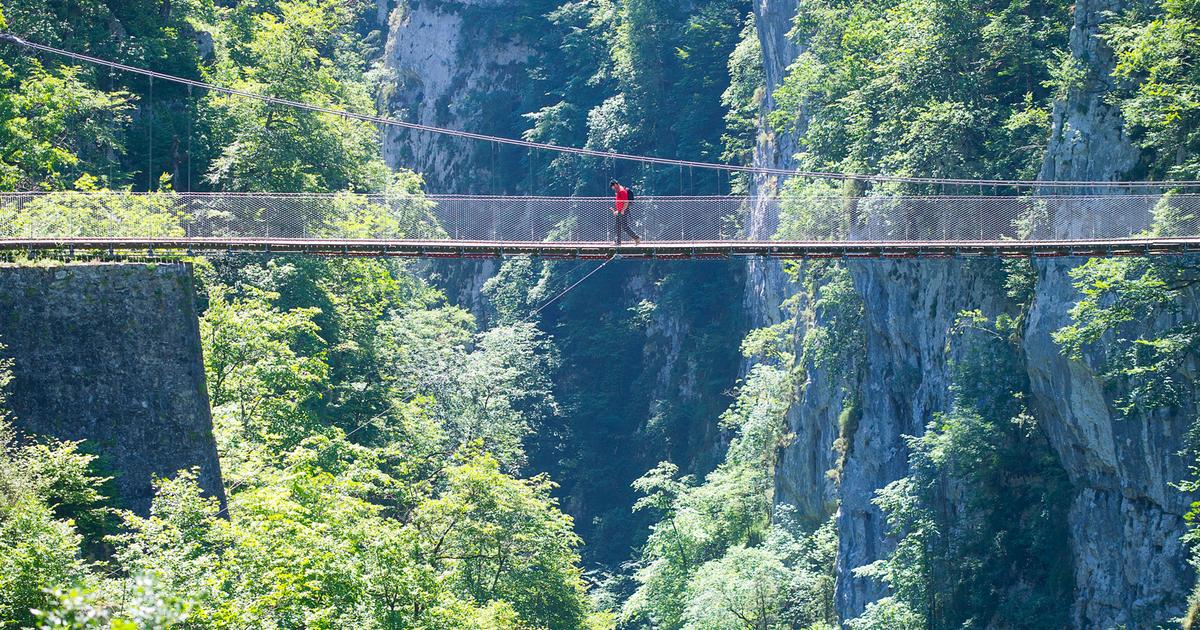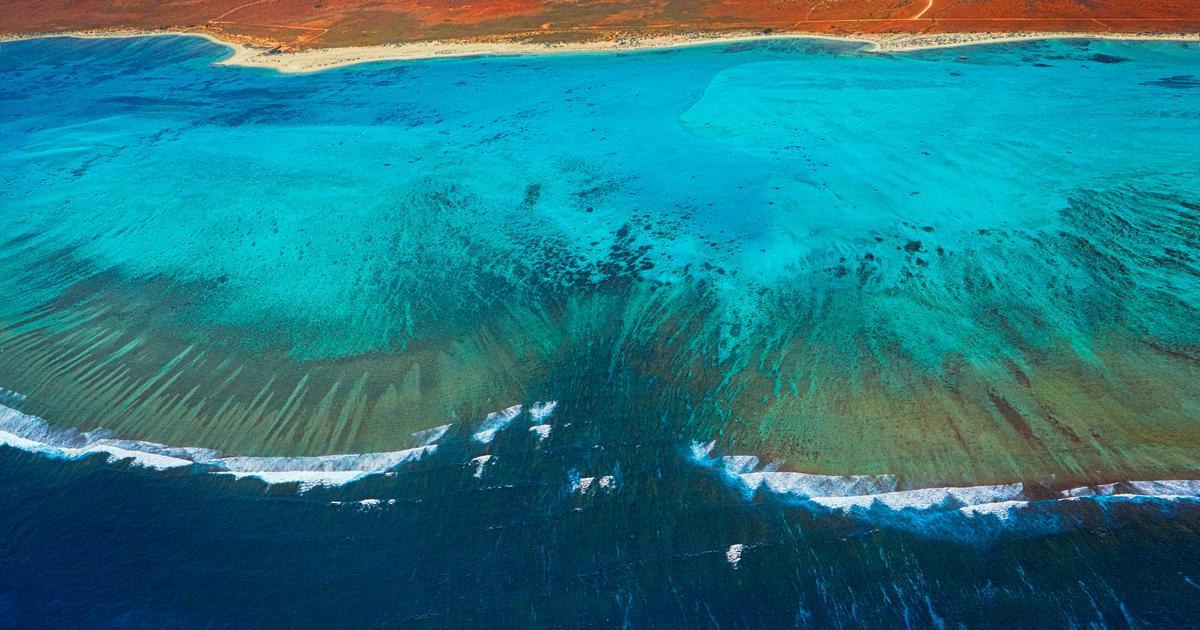Slowly, time and the elements did their work, the water split the rock creating gorges and canyons everywhere.
In the Pyrenees there would be nearly 700, counting those in Spain.
These geological splendors are today high places of tourism, obligatory passages for lovers of spectacular landscapes, but also for those who seek strong sensations, in particular by practicing hiking, canyoning or rafting.
Here are five of the most beautiful Pyrenean gorges, to be discovered from the Atlantic to the Mediterranean.
To discover
Stays in France: weekends, hotels and tailor-made stays from our partners
Olhadubi Gorge
From a distance, it seems very fragile, suspended 150 meters above the void and connected to the cliff by simple steel cables.
In Haute Soule (Basque Country), the
Holzarté footbridge
crosses the Oldhadubi gorges right through.
It was built in 1920 to allow the exploitation of the forest of Holzarté.
Painfully shaken by the storm Xynthia, it was restored in 2010. Every year, thousands of hikers take its 70 meters long, sometimes leaning to see, 150 meters below, the discreet Olhadoko Erreka who shaped these gigantic gorges of 'Olhadubi.
How to get there ?
From Mauléon-Licharre or Oloron-Sainte-Marie (depending on whether you arrive via Bordeaux or Toulouse and Pau), follow the direction of Larrau.
Just before Larrau, park at the Logibar hostel.
The Holzarté footbridge is an hour's walk away, achievable with the family.
Namely:
a few kilometers from Holzarté, are the Kakuetta gorges known for their lush vegetation.
Since a dramatic accident in 2020, they remain closed for the moment for safety reasons.
By canoe in the Aude gorges
The tumultuous waves of the Aude gorges aboard a raft or a canoe-kayak.
R. Kann / ADT Aude
To admire the work of the Aude river which has dug impressive gorges in the limestone, you can simply drive between Quillan and Axat, on the D117, admiring in particular the curious "
trou du curé
", a tunnel dug in the 19th century. century by Father Félix Armand and his parishioners.
You can also decide to put on a life jacket to defy the turbulent waves aboard a raft or a canoe-kayak.
Eight kilometers long, shallow and very narrow – barely twenty meters wide upstream from Axat – the Aude gorges offer beautiful rapids to discover by rafting or
hydrospeed
.
How to get there ?
From the A61, exit at Carcassonne and join Limoux then Quillan via the D118.
The Gorges de la Pierre Lys are located just after the village of Belvianes-et-Cavirac.
Those of Saint-Georges, upstream of Axat.
Read alsoIn the Aude, taste the heritage and natural wonders of the Cathar country
Galamus Gorge
The scenic route of the Galamus gorges is so narrow that traffic is alternated in summer.
Vincent / ADT of Aude
Catalans and Aude residents share this grandiose site shaped by the Agly river as it tumbles down to the Mediterranean.
Dizzying, arid and rocky, the Galamus gorges are worth as much for the biodiversity that inhabits its cliffs – golden and Bonelli eagles, peregrine falcons and other eagle owls –, its canyoning routes, as for its picturesque road, so narrow that the circulation is alternated in summer.
The wild and majestic character of the site attracted, from the 7th century and until the 1960s, a multitude of hermits who came to seek tranquility in the natural caves that dot the cliffs.
Architectural feat,
the Ermitage Saint-Antoine de Galamus
was built in a natural cavity.
Buildings and squares are literally clinging to the slope, dominating the canyon in a breathtaking landscape.
How to get there ?
From Carcassonne, reach Quillan, Axat, then Saint-Paul-de-Fenouillet.
The cave car park is on the D7.
To visit the Ermitage Saint-Antoine de Galamus and its cave-chapel: 04 68 73 70 98.
At the foot of the Canigó, the Carança
To visit the Carança gorges, all you have to do is put on hiking boots and forget your fear of heights!
Richard Sprang / CRT Occitanie
To visit the Carança gorges, all you have to do is put on hiking boots and forget your fear of heights!
Perched at some 1,000 meters above sea level, a stone's throw from Canigó, the sacred mountain of the Catalans, this canyon of abyssal depth can be traversed according to footbridges, rope bridges and above all a vertiginous path carved into the rock in 1943 to serve a hydraulic site.
From
Thuès-entre-Valls
, there is something for all tastes and all conditions.
For the short loop to El Fornàs, count an hour's walk;
five hours to the stone bridge.
The more athletic can even continue to the Carança refuge, guarded in summer (8h).
How to get there ?
The most picturesque option is undoubtedly to board the Yellow Train, departing from Villefranche-de-Conflent or Latour-de-Carol, and get off at the Thuès-Carança stop.
By car, take the RN116.
The paid car park is located in the town of Thuès-entre-Valls.
Read alsoHiking in summer: ten essentials to slip into your backpack
Between Aragon and Catalonia: the Congost de Mont Rebei
Mont Rebei.
xavier
On the other side of the Pyrenees, the canyons that streak the mountain have nothing to envy to those of Colorado.
Aragon is undoubtedly the province with the most spectacular gorges, like those of Añisclo.
On the border with Catalonia, the Congost de Mont Rebei is another marvel.
In the Sierra de Montsec, the
Noguera Ribagorçana
has cut into the limestone, carving cliffs that rise up to 300 meters high above turquoise water.
Totally preserved, the site is only accessible after a thirty-minute walk on an old mule track.
Thanks to numerous itineraries, which can be done on foot or by canoe, you can discover a succession of curiosities, such as the Romanesque chapel of La
Pertusa
,
Colomera
, Lake
Canelles
or the footbridges of Montfalcó.
How to get there :
On the A64, take exit 17 towards Lleida.
Continue on the N125, cross the border, Bossost, Vielha and its tunnel.
At Puente de Montañana, turn towards Tremp.
The track that goes up to the Congost de Mont-Rebei reserve is on the right, just after the bridge over the Noguera Ribagorçana.


/cloudfront-eu-central-1.images.arcpublishing.com/prisa/YCDI3SJOR5EAXMITQIYZALNNQI.jpg)




